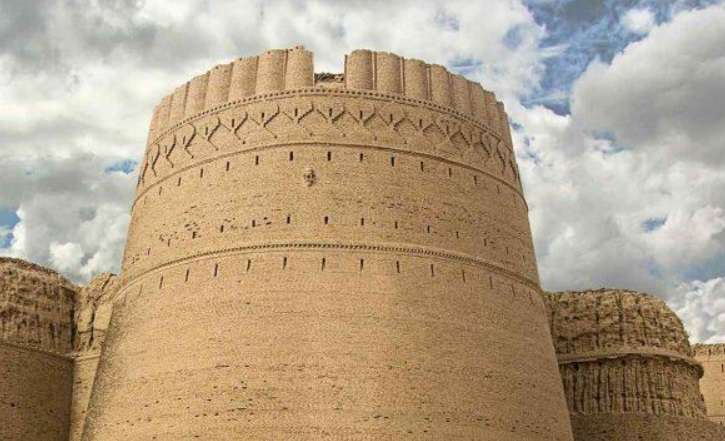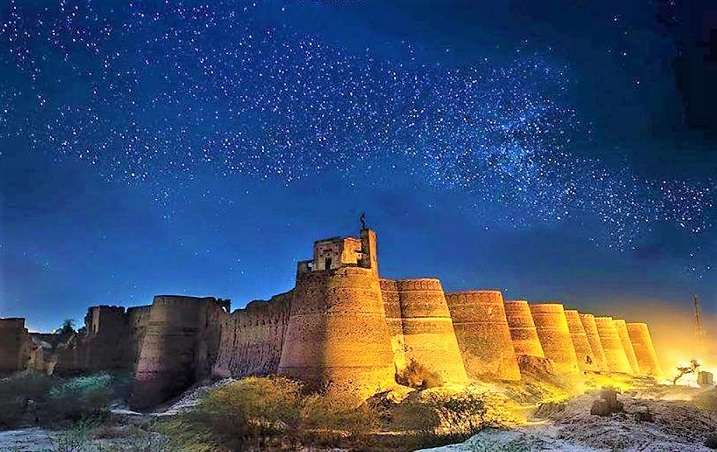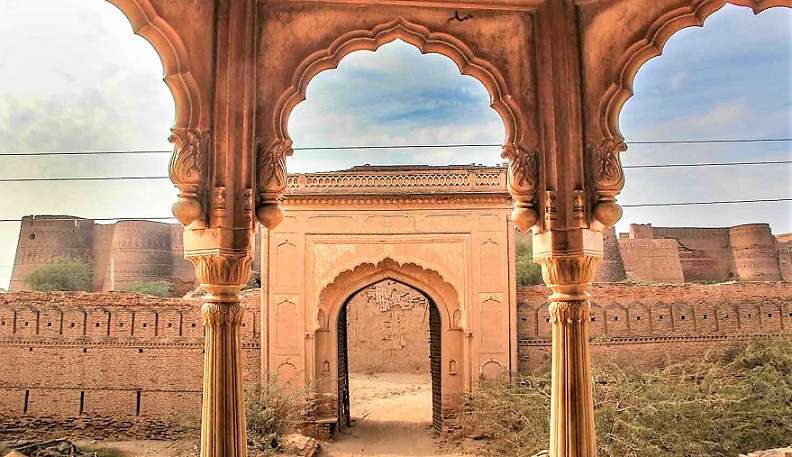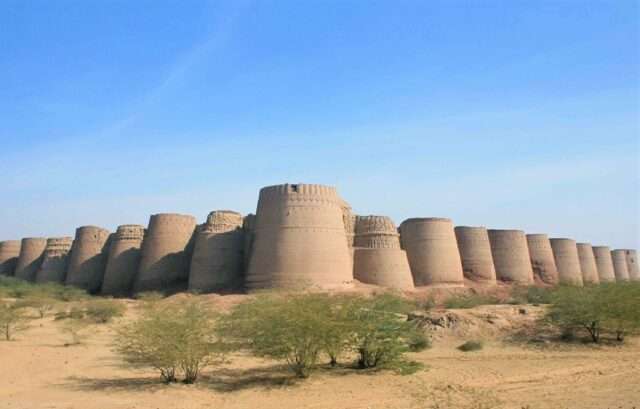Derawar Fort: The Great Elegance in Desert is an ancient fort ( قلعہ ) situated in the center of Cholistan desert.
It situated is almost 20 kilometers from Ahmadpur, a district of Bahawalpur and around around 80 kms from Yazman, another district of Bahawalpur.
The western portion of the Thar desert of the subcontinent is known as the Cholistan desert, or Rohi.
The Cholistan desert consists of more than a dozen historic forts in which a few are still intact but some others are not in good condition.
A few of these forts were built in the pre-Mughal era whereas, majority of these forts were renovated in the 16th, 17th and 18th centuries.
Derawar Fort is the one of the surviving mediaeval forts in this area of the world. The actual name of this ancient fort was Dera Rawal that was renamed to Dera Rawar, afterwards.
Read Also
Exuberant Wild life in Cholistan
However, after many centuries, people started it pronouncing as Derawar, and now it is the official name of this ancient fort.
1. History
This beautiful fort was built at the bank of Hakra river. Once can still see the sign’s of river’s bed engraved into the desert. However, the Hakra river was dried and this green part of Cholistan desert turned into a desolate and hostile landscape.
Rai Jajja built the the original Derawar fort in the 9th century AD as a tribute to Deoraj Bhati, who was the ruler of Jaisalmer and Bahawalpur.
In 11 CE, Muhammad-bin-Qasim, an Arab commander, took control of this fort. Afterwards, the Emirate of Multan continued to govern it for many years.
In 1008, Mahmood Ghaznavi conquered this area and took control of the Derawar fort. For many years, it was governed by the Delhi Sultanate.
The Mughals took charge of this this fort and ruled over it from the beginning of the 16th century to the end of the 18th century.
However, the last rulers of this wonderful and ancient fort were the Abbasi rulers as they took control of this in 18th century.
Read Also
Fairy Meadows National Park is Heaven on Earth
Nawab Sadiq Muhammad reconstructed Derawar fort in its present form in 1732. The final king of this fort, Muhammad Khan Abbasi V, was born in this fort, in 1904.
The credit of Derawar Fort’s current shape and architecture goes to the Abbasi rulers who ruled this area in 18th and 19th century. Derawar Fort: The Great Elegance in Desert is a majestic place to visit.
2. Architecture
The Derawar Fort is a sizable square castle located in Punjab, Pakistan’s Ahmadpur East Tehsil. The forty bastions of Derawar can be seen for many kilometer’s in the Cholistan Desert.

Derawar is an archaeological proof that Indus Valley culture was formerly resided in this region and the civilization of this area is known as Hakra Civilization, that was originally irrigated by the Hakra River.
The walls of the Derawar Fort are up to thirty meter’s high and have a perimeter of 1500 meter’s. The walls are still standing and these are in fair condition.
In the middle of the Cholistan Desert, this historically significant fort is an immense and spectacular building, but it is fast degrading and requires prompt preventive measures for preservation.
The tombs of the Amirs of Bahawalpur are embellished with lovely blue glazed tiles that contrast with the fort’s ochre surroundings.
Derawar Fort is a fascinating relic of the area’s rich past and is a well-known historical destination in the huge Cholistan Desert.
Read Also
The Attock Fort – A Beauty in Oasis
Derawar Fort’s spectacular architecture, which dates to the ninth century AD, stands tall in the arid wilderness and speaks volumes about the past.
3. Location
Derawar fort is located almost 20 kilometers from Ahmadpur, a district of Bahawalpur and around around 80 kms from Yazman, another district of Bahawalpur.
There are two routes to reach the Derawar fort. One is to first reach Yazman from Bahawalpur, and then to Drawar Fort and secondly to go Ahmadpur from Bahawalpur and then go to Derawar fort..
You can easily appreciate the artistic carvings on the fort’s exterior and interior surfaces by taking a closer look at the construction. Derawar Fort: The Great Elegance in Desert is a place worth to read about.
The fort’s construction has suffered some effects of time, yet it still appears as spectacular as it did when it was first constructed. Look at the photo up top once more.

The fort is a massive and visually stunning square structure built of clay bricks. The walls have a length of 1500 meters and stand up to thirty meters high.
There are forty circular bastions, ten on each side, which stand 30 m high and are visible across the desert for many miles. Each is decorated with intricate patterns in cut brick work.
There are remains of structures inside the fort, may richly decorated with tile and fresco work; the Moti or Pearl Mosque stands nearby and the cemetery of the Nawabs of Bahawalpur filled with ornate and elaborate graves.
4. Travel and Tourism
The Derawar fort’s foundation stone was placed based on historical records, about 800 years ago. But in 1733 A.D., it was taken over and entirely reconstructed by the Nawabs of Bahawalpur.
Read Also
Darbar Mahal – A jewel of Bahawalpur
The Nawab of Bahawalpur lost control of the fort just a few years later as a result of unrest in the area. They did, however, retake the fort in the nineteenth century, and they remained in control of the region for a considerable amount of time.
The fort was regularly maintained throughout the Nawabs of Bahawalpur’s rule, and it was in excellent condition. Derawar Fort: The Great Elegance in Desert.

Abbasi Masjid, which is close to Derawar Fort and is one of the major reminders of the glorious rule of the Nawabs of Bahawalpur in the area of the Cholistan Desert, lower Punjab, has already been noted.
Cholistan Jeep rally is an annual function that takes place at Derawar fort each year in February.
The Forts of Cholistan are a prime illustration of how people interacted with the harsh desert environment and made efforts to manage, protect, and reap the benefits of the limited water resources that were necessary for caravan transit in this corridor.
The Derawar Fort is a remarkable site in the Cholistan desert with its iconic architecture signifying centuries of opulence. But despite its incredible attractiveness, it appears to be about to crumble as a result of officials’ disregard.









